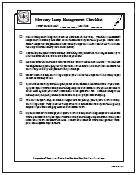Everyday Hazmat User’s Training Guide
Section II Waste Management (continued)
Common Regulated Wastes (continued)
Fluorescent Lamps
Mercury-containing lamps are found in nearly every USDA Forest Service building. Most common fluorescent lamps contain mercury that can leak into the soil of a landfill or into the air as a dangerous pollutant. Buy low-mercury fluorescent lamps to avoid regulatory issues. Fluorescent lamp ballasts that do not say No PCBs cannot be disposed of in the trash; they are a hazardous waste.
Mercury Lamp Collection Area
When a mercury-containing lamp (a fluorescent lamp) becomes a waste, you must take special precautions. Store discarded fluorescent lamps in a container marked: MERCURY-CONTAINING LAMPS FOR RECYCLING. The container must be composed of a material that will prevent the fluorescent lamps from breaking.

Do NOT discard fluorescent
lamps
or PCB ballasts in the
trash.
Crushing Mercury Lamps
Crushing mercury lamps is not recommended. If lamps are crushed, you must ensure that all vapor (which contains mercury) is captured and contained, as well as all glass shards and residues.
Fluorescent Lamp Recycling
Some recycling centers take discarded mercury-containing fluorescent lamps. These centers properly crush them, remove the contents, and manage the waste for you. You can transport discarded fluorescent lamps in USDA Forest Service vehicles. Keep recycling information, including dates, amounts, destination, and transporter and recycler in your files.
 Sample checklist for personnel handling fluorescent lamps that contain mercury. See the appendix. |
 Sample recordkeeping form for recycling fluorescent lamps that contain mercury. See the appendix. |
Unknown Wastes
Containers with unknown contents can be found at some USDA Forest Service units, often in their original container, but with no label. Other times you might find an open 55-gallon drum in a boneyard. Are its contents just water? You must use certain precautions when you find unknown wastes.
A Potentially Dangerous Situation
- Never open a closed container to determine
its contents!
- Notify your hazmat coordinator of the container.
- Never move
a container with unknown contents.
- Immediate action is required, especially
if damaged or rusted
containers might leak.
- Be absolutely sure your information is accurate before
relying on
prior knowledge to determine the contents of an unmarked
container.
- A laboratory analysis of unknown substances may be required to
determine the contents of unmarked containers; leave this task
to experts.
- If your unknown wastes are determined to be hazardous, refer to the Hazardous Wastes guideline.

Do NOT discard containers
with
unknown contents in
the trash.
What If the Unknown Wastes Are Just Used Oil?
Usually a container with unknown contents turns out to contain a nonhazardous or easily managed substance like used oil or antifreeze. BUT, until you know what the waste is, you must assume it is one of the most dangerous substances that can be found—it just might be!
Hazardous Wastes
Hazardous wastes are highly regulated by Federal and State laws. Hazardous wastes usually begin as hazardous products and become wastes when they are no longer usable. While it is wise to minimize hazardous wastes, dealing with them is straightforward. Some suggestions are presented in this guideline.
How To Determine if a Waste Is Hazardous
If the product to be discarded has a flashpoint below 140°F, or a pH below 2.5 or above 12.5, it is a hazardous waste; you can find this information on the product’s MSDS.
If the product contains chemicals regulated by the EPA, it is a hazardous waste. Look in section II of the MSDS (page 6) to determine whether the product has such chemicals. If any such chemicals are listed, the product will become a hazardous waste; if no chemicals are listed, it will probably not be a hazardous waste.
If you are uncertain, ask your hazmat coordinator for help.

Do NOT discard hazardous
wastes in the trash.
Expected User Actions for a Hazardous Waste
- Make sure the hazardous waste
has the original product label; label it again if necessary.
- Move the material
to your unit’s designated hazardous waste accumulation area.
- Make sure the
container is securely closed.
- Inform the hazardous waste accumulation area manager that you have just moved some hazardous waste into the area. The container will need to be labeled as a hazardous waste with the date it was moved to the area. The container must be checked to make sure it is sound and securely closed. The accumulation area log will need to be updated.
Handy Tips
- Minimize hazardous wastes by buying
nonhazardous (green) products.
- Buy only
the quantity you need for a task.
- Use up
or transfer obsolete hazardous products to other USDA Forest Service
units that
can use
them, to avoid having them become hazardous wastes.
- Keep all records; the
records could be important in the future.
- Involve everyone
in hazardous waste management and explain the cost of management to help
everyone
appreciate
the expense of using hazardous products.
- Move to low-mercury and high-efficiency
fluorescent lamps and electronic ballasts to conserve energy.
- Do a ranger district cleanup
to find all old products and unknown containers.
- Look for green products at the USDA Forest Service green purchasing Web site: /eng/t-d.php?link=everyday_hazmat/green.htm
